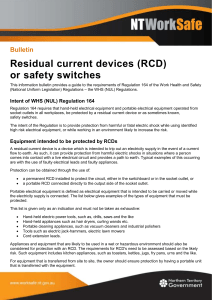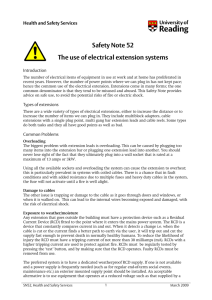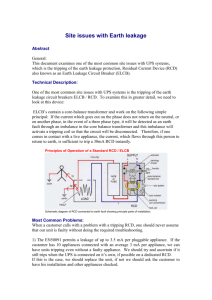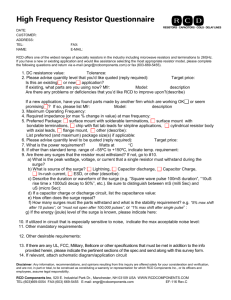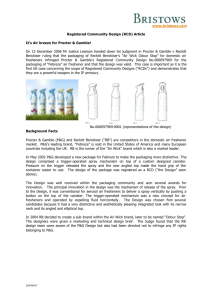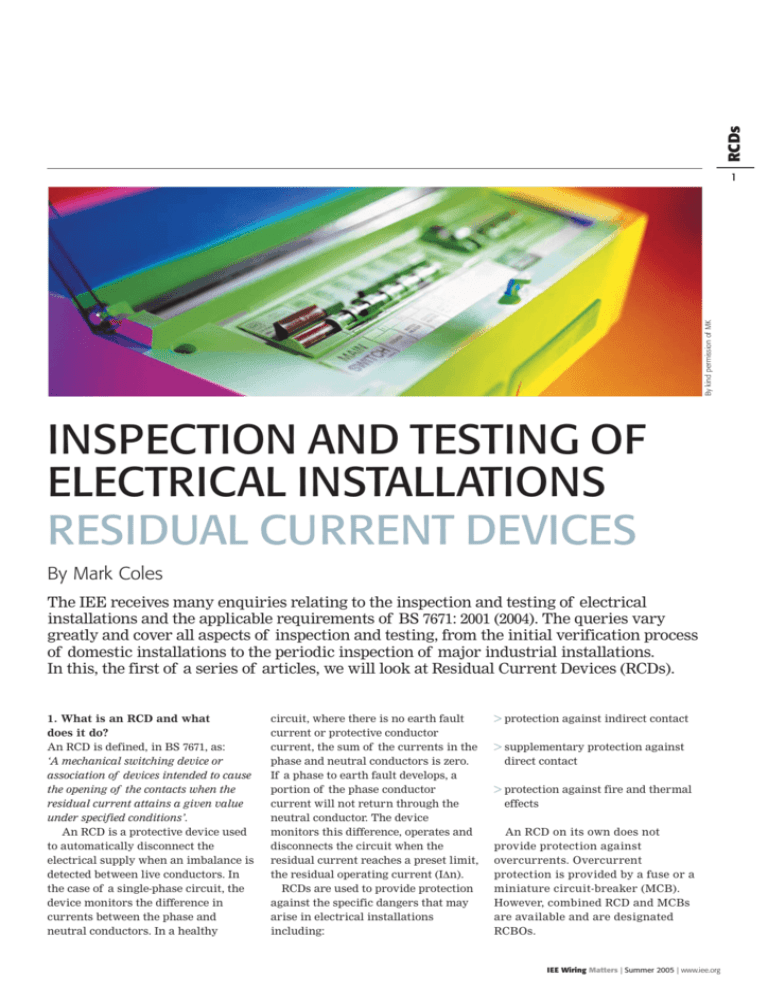
RCDs
By kind permission of MK
1
INSPECTION AND TESTING OF
ELECTRICAL INSTALLATIONS
RESIDUAL CURRENT DEVICES
By Mark Coles
The IEE receives many enquiries relating to the inspection and testing of electrical
installations and the applicable requirements of BS 7671: 2001 (2004). The queries vary
greatly and cover all aspects of inspection and testing, from the initial verification process
of domestic installations to the periodic inspection of major industrial installations.
In this, the first of a series of articles, we will look at Residual Current Devices (RCDs).
1. What is an RCD and what
does it do?
An RCD is defined, in BS 7671, as:
‘A mechanical switching device or
association of devices intended to cause
the opening of the contacts when the
residual current attains a given value
under specified conditions’.
An RCD is a protective device used
to automatically disconnect the
electrical supply when an imbalance is
detected between live conductors. In
the case of a single-phase circuit, the
device monitors the difference in
currents between the phase and
neutral conductors. In a healthy
circuit, where there is no earth fault
current or protective conductor
current, the sum of the currents in the
phase and neutral conductors is zero.
If a phase to earth fault develops, a
portion of the phase conductor
current will not return through the
neutral conductor. The device
monitors this difference, operates and
disconnects the circuit when the
residual current reaches a preset limit,
the residual operating current (I∆n).
RCDs are used to provide protection
against the specific dangers that may
arise in electrical installations
including:
> protection against indirect contact
> supplementary protection against
direct contact
> protection against fire and thermal
effects
An RCD on its own does not
provide protection against
overcurrents. Overcurrent
protection is provided by a fuse or a
miniature circuit-breaker (MCB).
However, combined RCD and MCBs
are available and are designated
RCBOs.
IEE Wiring Matters | Summer 2005 | www.iee.org
RCDs
2
Type of RCD
Description
Usage
RCCB
Residual current operated circuit-breaker
without integral overcurrent protection
Device that operates when the residual
current attains a given value under specific
conditions
Consumer units
Distribution boards
RCBO
Residual current operated circuit-breaker
(RCCB) with integral overcurrent protection
Device that operates when the residual current Consumer units
attains a given value under specific conditions Distribution boards
and incorporates overcurrent protection
CBR
Circuit-breaker incorporating residual
current protection
Overcurrent protective device incorporating
residual current protection.
Distribution boards in larger
installations
SRCD
Socket-outlet incorporating an RCD
A socket-outlet or fused connection unit
incorporating a built-in RCD.
Often installed to provide
supplementary protection
against direct contact for
portable equipment used out of
doors
PRCD
Portable residual current device
A PRCD is a device that provides RCD
protection for any item of equipment
connected by a plug and socket. Often
incorporates overcurrent protection
Plugged into an existing socketoutlet. PRCDs are not part of
the fixed installation
SRCBO
Socket-outlet incorporating an RCBO
Socket-outlet or fused connection unit
incorporating an RCBO
Often installed to provide
supplementary protection against
direct contact for portable
equipment used out of doors
2. Types of RCDs
RCD is the generic term for a device
that operates when the residual
current in the circuit reaches a
predetermined value.
The list above indicates the different
types of RCD available, a description of
each device and examples of how the
device is used.
2.1 Older installations with ELCBs
Historically, two basic types of earthleakage circuit-breaker (ELCB) were
recognised by the Regulations; the
familiar current-operated type and the
earlier voltage-operated type. The
voltage-operated type ceased to be
recognised by the Regulations in 1981
and today, only the current-operated
type is recognised. The voltageoperated device can be distinguished
by its two separate earthing terminals
– one for the connection of the
earthing conductor of the installation
and the other for a connection to a
means of earthing. Such devices were
often used on installations forming
part of a TT system where the means
of earthing was an earth electrode.
The major drawback with the voltageoperated earth leakage circuit-breaker
is that a parallel earth path can disable
the device.
2.2 Recognised devices
RCDs are manufactured to harmonised
standards and can be identified by their
BS EN numbers. An RCD found in an
older installation may not provide
Published by IEE Publishing & Information Services Michael Faraday House, Six Hills Way, Stevenage, Herts, SG1 2AY, United Kingdom
Tel: +44 (0)1438 313311 Fax: +44 (0)1438 313465
Sales and Project Coordinator K Hunton +44 (0)1438 767224 khunton@iee.org.uk | Editor G D Cronshaw +44 (0)1438 767384
gcronshaw@iee.org.uk | Contributing Editors N Canty, M Coles, P Cook, J Ware | Chief Sub Editor Jim Hannah | Design SaBle Media Solutions
IEE Wiring Matters is a quarterly publication from the Institution of Electrical Engineers (IEE). The IEE is not as a body responsible for the
opinions expressed. To recieve a free copy of Wiring Matters email: advertising@iee.org.uk
©2005: The Institution of Electrical Engineers. All rights reserved. No part of this publication may be reproduced, stored in a retrieval system,
or transmitted in any form or by any means without the permission in writing of the publisher. Copying of articles is not permitted except for
personal and internal use. Multiple copying of the content of this publication without permission is always illegal. Web-offset printing by
Wyndeham Heron, The Bentall Complex, Colchester Road, Heybridge, Maldon, Essex, UK
Co-operating Organisations The Institution of Electrical Engineers acknowledges the contribution made by the following
organisations in the preparation of this publication: British Electrotechnical & Allied Manufacturers Association Ltd – R Lewington,
P D Galbraith, M H Mullins | Office of the Deputy Prime Minister – K Bromley, I Drummond | Electrical Contractors Association – D Locke,
S Burchell | City & Guilds of London Institute – H R Lovegrove | Energy Networks Association –D J Start | Electrical Contractors Association
of Scotland SELECT – D Millar, N McGuiness | Health & Safety Executive – N Gove | National Inspection Council for Electrical Installation
Contracting | ERA Technology Limited - M Coates | British Cables Association – C Reed
IEE Wiring Matters | Summer 2005 | www.iee.org
RCDs
4
protection in accordance with current
standards. The following list identifies
the applicable current standards:
> BS 4293 : 1983 (1993)
Specification for residual current operated
circuit-breakers. (Replaced by BS EN 610081: 1995, BS EN 61008-2-1: 1995 and BS
IEC 61008-2-2: 1990). This Standard
remains current
> BS 7071 : 1992 (1998)
Specification for portable residual current
devices
Labelled
Main Switch
> BS 7288 : 1990 (1998)
Specification for socket-outlets incorporating
residual current devices. (SRCDs)
> BS EN 61008-1 : 1995 (2001)
Residual current operated circuit-breakers
without integral overcurrent protection for
household and similar uses (RCCBs)
> BS EN 61009-1 : 2004
Residual current operated circuit-breakers
with integral overcurrent protection for
household and similar uses (RCBOs)
2.3 Characteristics of RCDs
RCDs are defined by a series of
electrical characteristics, three main
characteristics are:
1. The rating of the device in amperes, I.
2. The rated residual operating
current of the protective device in
amperes, I∆n.
3. Whether the device operates
instantaneously or incorporates an
intentional time delay to permit
discrimination. Such devices are
called ‘S’ or Selective.
Devices are manufactured with
different values of rated current and
rated residual operating current but we
will just consider the rated residual
operating current of the protective
device in amperes, I∆n.
3. Applications
The correct device must be selected for
IEE Wiring Matters | Summer 2005 | www.iee.org
Above: DIscrimination achieved
the particular application. Choosing
the wrong device could have serious
consequences and could result in
electric shock or fire.
The list overleaf gives examples of
particular applications of RCDs and
includes references to the relevant
Regulations in BS 7671.
3.1 Unwanted tripping
Unwanted tripping of RCDs can occur
when a protective conductor current or
leakage current causes unnecessary
operation of the RCD. An RCD must be
so selected and the electrical circuits
so subdivided that any protective
conductor current that may be
expected to occur during normal
operation of the connected load(s) will
be unlikely to cause unnecessary
tripping of the device (Regulation 53102-04 refers). Such tripping can occur
on heating elements, cooking
appliances etc., which may have
elements that absorb a small amount of
moisture through imperfect elementend seals when cold. When energised,
this moisture provides a conductive
path for increased leakage and could
operate the RCD. The moisture dries
out as the element heats up. Although
not precluded in BS 7671, it is not a
requirement to use an RCD on such
circuits if other satisfactory means of
protection are available. Providing an
RCD with a higher rated residual
operating current may solve the
problem but the requirements of the
Regulations would still have to be met.
3.2 Discrimination
Where two, or more, RCDs are connected
in series, discrimination must be
provided, if necessary, to prevent danger
(Regulation 531-02-09 refers). During a
fault, discrimination will be achieved
when the device electrically nearest to
the fault operates and does not affect
other upstream devices.
Discrimination will be achieved when
‘S’ (Selective) types are used in
conjunction with downstream general
type RCDs. The ‘S’ type has a built-in
time delay and provides discrimination
by simply ignoring the fault for a set
period of time allowing more sensitive
downstream devices to operate and
remove the fault.
For example, when two RCDs are
connected in series, to provide
discrimination, the first RCD should
be an ‘S’ type. RCDs with built in time
delays should not be used to provide
personal protection.
RCDs
6
RCD, I∆n
Application
Regulation
10mA
A very sensitive device that is sometimes used to protect laboratory benches in schools
412-06-02
30mA
Portable equipment used outdoors must be protected by an RCD with a rated residual operating current
not exceeding 30mA
471-16-01
412-06-02
30mA
Certain equipment in bathrooms and shower rooms must be protected by a 30mA RCD. For example, a 230V
fan in zone 1 of a bathroom, that cannot be located elsewhere, must be protected by a 30mA device and must
have an IP rating of at least IPX4 (IPX5 if hosed down)
601-09-02
601-06-01
30mA
Mains-supplied socket-outlets in bedrooms with showers must be protected by an RCD. Note that such
socket-outlets must be located outside of the zones
601-08-02
30mA
Socket-outlets in workshops, school laboratories, used by performers and entertainers. Street market stalls
are often protected by 30mA RCDs.
412-06-02
30mA
In zone C of swimming pool installations, luminaires must be protected either by electrical separation, SELV 602-08-03
or a 30mA RCD.
30mA
Any socket-outlet used on a building site must be to BS EN 60309-2 and must be protected by a 30mA
RCD.
604-08-03
604-12-02
30mA
Caravans, motor caravans and caravan parks. 30mA RCDs must be provided both in the vehicle and the
park installation.
608-03-02
608-07-04
608-04-01
30mA
Caravan pitch socket-outlets – Each socket-outlet must be protected individually by an overcurrent device, 608-13-04
which may be a fuse but is more usually a circuit-breaker and either individually or in groups of not more
608-13-05
than three socket-outlets by an RCD having the characteristics specified in Regulation 412-06-02. Note: the
CENELEC harmonisation document HD 384.7.708 allows only three sockets to one RCD while the
international standard IEC 364-7-708 permits six.
30mA
Underfloor heating systems are installed in bathrooms and swimming pools supplied at voltages other than
SELV, the heating element should be provided either with a metallic sheath or screen overall or a metallic grid
installed above the heating elements. The screen or grid shall be incorporated within the supplementary
bonding for the facility. In addition, the supply to the heating elements should be protected by an RCD with a
residual operating current not exceeding 30mA.
601-09-04
100mA
For an installation forming part of a TT system, a 100mA RCD is generally installed at the origin. A time-delayed or
100mA ‘S-type’ (or selective) device is often used to permit discrimination with a downstream 100mA device
413-02-19
531-02-09
314-01-02
100mA
Where an RCD is fitted only because the earth loop impedance is too high for shock protection to be provided by
an overcurrent device, for example in a TT system
413-02-16
100mA
Under certain supply-system fault conditions (external to the installation), a potential can develop between the
413-02-17
conductive parts connected to the PME earth terminal and the general mass of earth. However, there are areas of
special risk within or outside buildings and there are special situations and installations where it is appropriate to
take additional measures for part or all of the installation. Alternatively, it may be appropriate not to use the PME
earthing terminal and provide earth fault protection with a separate earth electrode and RCD. Seek advice from the
local supply authority when exporting PME supplies.
300mA
In TN and TT systems, in locations with risks of fire due to the nature of processed or stored materials, wiring
systems, except for MICC and busbar trunking systems must be protected against insulation faults to earth by a
300mA device
482-02-06
500mA
In agricultural and horticultural premises, a 500mA device must be installed to protect equipment against fire and
harmful thermal effects, other than that essential to the welfare of livestock.
605-10-01
500mA
At exhibitions, shows & stands, where there is increased risk of damage to cables, distribution circuits should be
protected by an RCD with a residual operating current not exceeding 500mA.
GN7, p95
Adjustable
≤2000 mA
Devices with a residual operating current of 2A or more are sometimes used in specific industrial and distribution
applications. Advice must be sought from the designer
531-02-10
IEE Wiring Matters | Summer 2005 | www.iee.org
RCDS
8
Device
Instrument test current setting
Satisfactory result
General purpose RCDs to 50% of operating current
BS 4293 and RCD
protected socket-outlets 100% of operating current
to BS 7288
Device should not operate
50% of operating current
General purpose RCCBs
to BS EN 61008 or RCBOs
100% of operating current
to BS EN 61009
Device should not operate
Supplementary
protection against direct
contact
I∆n ≤ 30mA
Device should operate in less than 200ms. Where the RCD
incorporates an intentional time delay it should trip within a
time range from 50% of the rated time delay plus 200ms’
to 100 % of the rated time delay plus 200ms
Device should operate in less than 300ms unless it is of
‘Type S’ (or selective) which incorporates an intentional
time delay. In this case, it should trip within a time range
from 130ms to 500ms
Test current at 5 I∆n
Device should operate in less than 40ms.
The maximum test time must not be longer than
40ms, unless the protective conductor potential does
not exceed 50V. (The instrument supplier will advise on
compliance).
4. Labelling
Regulation 514-12-02, states that:
“Where an installation incorporates a
residual current device a notice shall be
fixed in a prominent position at or near
the origin of the installation. The notice
shall be in indelible characters not
smaller than those here illustrated and
shall read as follows:”
This installation, or part of it, is protected
by a device which automatically switches
off the supply if an earth fault develops.
Test quarterly by pressing the button
marked ‘T’ or ‘Test’. The device should
switch off the supply and should then
be switched on to restore the supply.
If the device does not switch off the
supply when the button is pressed,
seek expert advice.
5. Testing
RCDs must be tested. The
requirements are stated in the
following Regulations:
a. The effectiveness of the RCD must
be verified by a test simulating an
appropriate fault condition and
independent of any test facility, or
IEE Wiring Matters | Summer 2005 | www.iee.org
test button, incorporated in the
device (Regulation 713-13-01)
b. Where an RCD of 30mA provides
supplementary protection the
operating time must not exceed 40
ms at a residual current of 5 I∆n.
(Regulation 412-06-02 refers)
Tests are made on the load side of the
RCD between the phase conductor of
the protected circuit and the
associated cpc. Any load or appliances
should be disconnected prior to
testing. RCD test instruments require
a few milliamperes to operate; this is
normally obtained from the phase and
neutral of the circuit under test.
When testing a three-phase RCD
protecting a three-wire circuit, the
instrument’s neutral is required to be
connected to earth. This means that
the test current will be increased by
the instrument supply current and
will cause some devices to operate
during the 50% test, possibly
indicating an incorrect operating
time. Under this circumstance it is
necessary to check the operating
parameters of the RCD with the
manufacturer before failing the RCD.
5.1 Range of tests
While the following tests are not a
specific requirement of BS 7671, it is
recommended that they are carried
out.
5.2 Integral test device
An integral test device is incorporated
in each RCD. This device enables the
mechanical parts of the RCD to be
verified by pressing the button marked
‘T’ or ‘Test’.
6. Test Instrument
The test instrument used to test RCDs
should be capable of applying the full
range of test current to an in-service
accuracy, as given in BS EN 61557-6.
This in-service reading accuracy will
include the effects of voltage
variations around the nominal
voltage of the tester. To check RCD
operation and to minimise danger
during the test, the test current
should be applied for no longer than
2s. Instruments conforming to
BS EN 61557-6 will fulfil the above
requirements. ■


